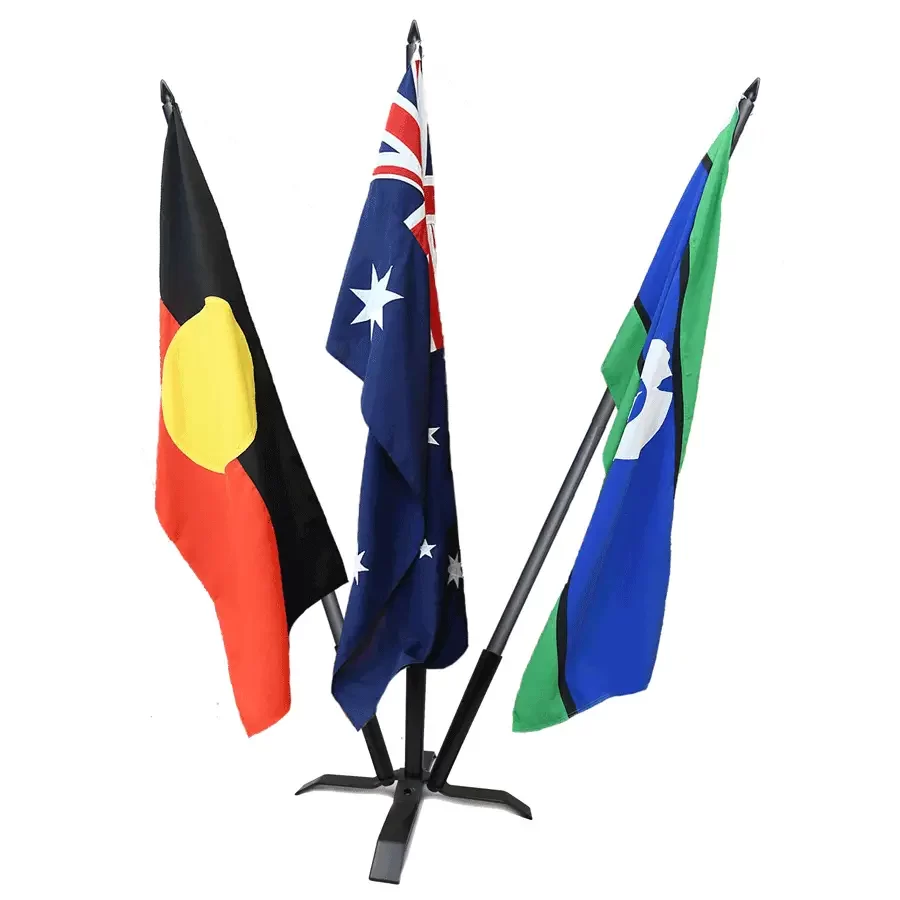Northern Territory
The Northern Territory (NT) is an Australian territory in the central and northern regions. It covers 1,349,129 square kilometres (520,902 sq mi), making it the third-largest Australian federal division.
Read more on the Northern Territory https://en.wikipedia.org/wiki/Northern_Territory
Map of Northern Territory
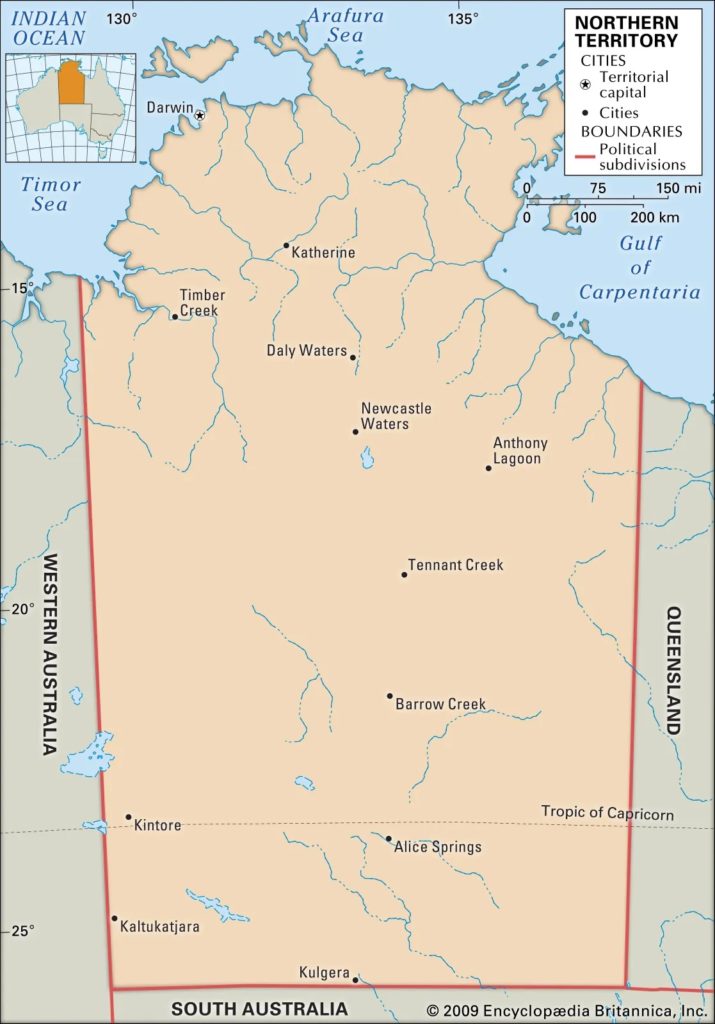
For more on the Northern Territory Map https://www.britannica.com/place/Northern-Territory
Coat of Arms for Northern Territory
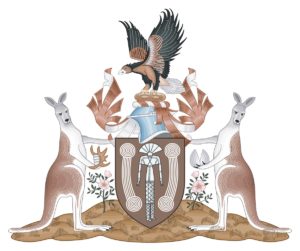 The coat of arms of the Northern Territory is the official heraldic symbol representing the Australian territory. They were officially granted by royal warrant of Queen Elizabeth II on 11 September 1978. The arms, uniquely in Australia, incorporate the territory’s floral, animal and bird emblems: the Sturt’s desert rose, red kangaroo and wedge-tailed eagle.
The coat of arms of the Northern Territory is the official heraldic symbol representing the Australian territory. They were officially granted by royal warrant of Queen Elizabeth II on 11 September 1978. The arms, uniquely in Australia, incorporate the territory’s floral, animal and bird emblems: the Sturt’s desert rose, red kangaroo and wedge-tailed eagle.
The Northern Territory’s arms incorporate many reflections of the indigenous Australian culture and history: the shield represents an Aboriginal painting, and the crest shows the wedge-tailed eagle on top of a tjurunga, an Aboriginal ritual stone.
For more on the Northern Territory Coat of Arms https://en.wikipedia.org/wiki/Coat_of_arms_of_the_Northern_Territory
Flag for Northern Territory
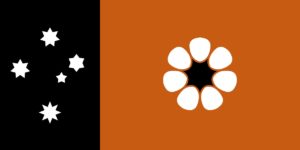 The current state flag of the Northern Territory was officially adopted by the Northern Territory, Australia, in 1978. The Northern Territory has been in existence since 1911, but did not hoist its first flag until self-government in 1978.
The current state flag of the Northern Territory was officially adopted by the Northern Territory, Australia, in 1978. The Northern Territory has been in existence since 1911, but did not hoist its first flag until self-government in 1978.
The flag differs from the flags of the Australian states as it does not include the British Blue Ensign. The flag’s colours consist of the official Territorian colours of black, white and ochre. The Southern Cross appears as five white stars on a black panel at the hoist. In the fly of the flag is a stylised Sturt’s Desert Rose, the territory’s floral emblem since 1961, with seven white petals representing the six Australian States and the Northern Territory and a black seven-pointed core.
For more on the Northern Territory Flag https://en.wikipedia.org/wiki/Flag_of_the_Northern_Territory
Emblems of the Northern Territory
Mammal Emblem
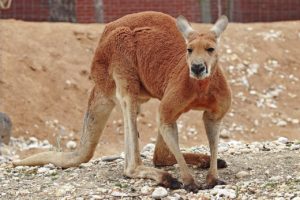 The red kangaroo embodies the NT’s unique wildlife. It is the largest living marsupial with adult males standing more than 2m tall and weighing as much as 75kg.
The red kangaroo embodies the NT’s unique wildlife. It is the largest living marsupial with adult males standing more than 2m tall and weighing as much as 75kg.
Males are a rusty brown colour and females a smoky grey, while both have heat-reflecting paler fur on their under surfaces. They also have striking white marks with a black line on the sides of their muzzles.
Their long, thin limbs allow them to travel large distances through harsh conditions. They are found in the NT in very dry areas.
Faunal Emblem
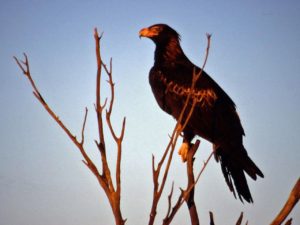 The Wedge-tailed eagle is Australia’s largest bird of prey with an average wingspan of 2.5m. It is dark brown with a chestnut neck.
The Wedge-tailed eagle is Australia’s largest bird of prey with an average wingspan of 2.5m. It is dark brown with a chestnut neck.
Their long, wedge-shaped tail and broad wings make them easy to recognise. Their legs are covered in feathers right down to their feet. A hooked beak and strong talons are the hallmarks of a bird that hunts other animals.
Although they are found throughout Australia, in the NT, they are more commonly found in the arid centre than on the coastal plains of the north.
They eat a range of small mammals that live on the soft ground cover, as well as other birds, rabbits and reptiles. It is thought the eagle also hunts kangaroos that gather around watering holes.
Floral Emblem
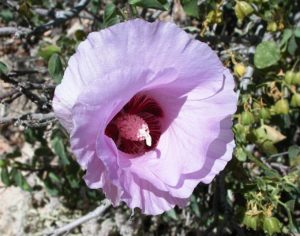 Sturt’s Desert Rose has been the floral emblem of the NT since 1974. It is an arid plant that grows best in the stony or rocky ground, such as dry creek beds.
Sturt’s Desert Rose has been the floral emblem of the NT since 1974. It is an arid plant that grows best in the stony or rocky ground, such as dry creek beds.
It is a member of the cotton family, rather than the rose family. It was named after Charles Sturt, who first collected it during his journey to Central Australia in 1844-45.
It’s a small bushy plant that usually grows to 1.5 m.
It has dark green, round to oval-shaped leaves. The petals of the flowers are mauve with a deep red marking at the base.
The flowers look similar to the hibiscus, which belongs to the same family. The plant’s fruit is capsule-shaped and contains small seeds covered in short hair, which is a trait of the cotton family.
For more on Northern Territory Emblems https://en.wikipedia.org/wiki/Symbols_of_the_Northern_Territory
and https://nt.gov.au/about-government/official-symbols-and-emblems
Colour Emblem
Black, White and Ochre
For more on the Colour Emblems https://en.wikipedia.org/wiki/Australian_state_and_territory_colours
Islands Governed by the Northern Territory
Melville Island
-
-
- Location: Timor Sea, part of the Tiwi Islands, approximately 80 km north of Darwin, Northern Territory
- Size: Approx. 5,786 km² (second-largest island in Australia after Tasmania)
- Population: ~2,000 (primarily Tiwi people)
- Main settlements: Milikapiti and Pirlangimpi
- Traditional Owners: Tiwi people
- Governed by: Northern Territory, under the Tiwi Land Council
- Access: By plane, ferry, or charter from Darwin (permit required)
-
Overview
Melville Island is the larger of the two main islands in the Tiwi group and holds immense cultural, historical, and environmental significance. Like Bathurst Island, Melville is home to the Tiwi people, who have maintained their distinct language, customs, and art traditions over thousands of years.
Despite its remote location, Melville Island sustains vibrant communities and traditional lifestyles that coexist alongside modern services and infrastructure. The island is an important hub for Indigenous governance, culture, and eco-tourism.
Cultural Significance
Melville Island is deeply embedded with Tiwi culture, with communities dedicated to preserving traditional practices, such as:
-
-
- Pukumani ceremonies and the crafting of Pukumani poles (decorated burial poles symbolising Tiwi beliefs about life and death)
- Rich body painting traditions are used in rituals and ceremonies
- A thriving Tiwi art scene, with local artists producing paintings, carvings, and weaving that are sought after nationally and internationally
- Maintenance of the Tiwi language and oral histories
-
Local art centres, cultural tours, and community-run experiences provide visitors with opportunities to engage respectfully with Tiwi culture.
Natural Environment
Melville Island features a diverse tropical landscape, including:
-
-
- Savanna woodlands and monsoon forests
- Extensive mangrove systems along the coast
- Wetlands that support an array of birdlife, reptiles, and mammals
- Beaches and marine habitats rich in turtles, dolphins, and fish
-
The island is also home to species unique to the region, including the Tiwi subspecies of the northern brushtail possum.
Access & Tourism
Visitors to Melville Island require permission from the Tiwi Land Council, and tourism is generally community-led to ensure cultural and environmental sensitivities are respected.
Getting there:
-
-
- Flights from Darwin (approx. 30 minutes)
- Boat transfers from Darwin (weather dependent)
-
Activities include:
-
-
- Cultural tours and art centre visits in Milikapiti and Pirlangimpi
- Fishing and boating excursions
- Wildlife observation and nature walks
- Participation in community festivals and sporting events (like the Tiwi Islands Football League)
-
Accommodation is limited and often basic, with some guesthouses and community lodges available.
Governance & Community
Melville Island, like Bathurst Island, is governed under the Tiwi Land Council, which manages land rights and works to support sustainable development and cultural preservation. The island’s communities actively balance traditional life with modern needs.
Why Visit Melville Island?
Melville Island offers a unique and immersive experience of Indigenous Australian life on a large and diverse tropical island. Visitors are welcome to explore rich cultural traditions, enjoy pristine natural environments, and witness the resilience and creativity of the Tiwi people.
Melville is best suited for travellers who seek cultural understanding, ecological adventure, and a genuine connection to Australia’s Indigenous heritage.
